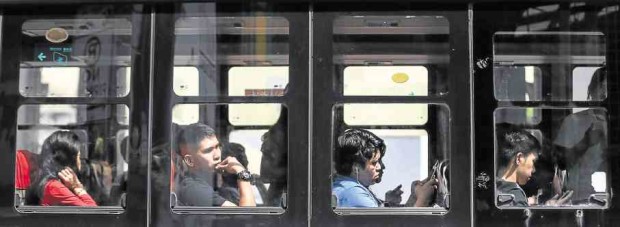PIDS study clearly defines who are real middle-class citizens in PH

Bus passengers use their gadgets to take their mind off the slow-moving traffic on Edsa. —LYN RILLON
MANILA, Philippines — More than a month after the entire Luzon was placed under lockdown to contain the spread of the coronavirus disease (COVID-19), President Rodrigo Duterte approved a P50-billion wage subsidy for middle-income workers.
This after mounting calls from public officials and lawmakers to include the middle class in the government’s cash aid program for some 18 million low-income families.
But who exactly belongs to the middle class?
A 2018 study by state-run think tank Philippine Institute for Development Studies (PIDS) showed that as of 2017, nearly half or 40.2 percent of the population falls under the middle-income class.
Click here to browse copy of the study
Nearly three-fifths or 58.4 percent belong to the low-income while the remaining 1.4 percent are considered members of high-income households.
The 2018 PIDS study said that those belonging to the middle-income class are families (or persons belonging to families) that have incomes between two and 12 times the poverty line.
This means that in 2017, a family of five would fall under the middle-income class if its monthly income ranged roughly between P20,000 and P115,000.
Residence
According to the study, “urban dwellers are predominantly middle income” earners.
The study said that in 2015, three in five urban residents were middle-income, while only one in 20 was high-income.
The study also said that it is in the National Capital Region, Central Luzon, and Calabarzon where the middle class dominantly resides.
“In 2015, more than half of them lived in these areas. As these areas have wide access to commercial and manufacturing establishments, most of the middle class also work in these regions,” the study said.
The study also noted that in Metro Manila, “tenure status is different from the rest of the country.”
While 58 percent of middle-income residents in Metro Manila have their own homes, 35 percent rented houses and seven percent were informal settlers.
“While a relatively small proportion of middle-income households live as informal settlers, they constitute a big proportion of informal settlers nationwide,” the study said.
It added that in 2015, two in every five informal settlers or 42 percent belonged to the middle-income class. The remaining 58 percent were from the low-income class.
“In Metro Manila alone, roughly 7 in every 10 (69%) informal settlers belonged to the middle-income class in 2015, which is contrary to the conventional view that informal settlers in urban areas are the urban poor,” it said.
Employment
Citing merged data from the Labor Force Survey and the Family Income and Expenditure Survey (FIES) of the Philippine Statistics Authority in 2015, the study noted that members of middle-income households work outside the agriculture sector.
“In fact, only 11 percent of them depended on agriculture, most of whom belonged to the lower-middle-income cluster,” the study said.
Meanwhile, a quarter of the middle income worked in wholesale and retail trade, with jobs such as vegetable vendors or sari-sari store owners, the study added.
“Nearly a fifth (17%) were in transport, communication, and storage, usually working as tricycles and jeep drivers or bus conductors. Meanwhile, about 16 percent worked in government, mostly as clerks or public school teachers,” it noted.
The findings of the study showed that middle-income households in the country have better access to health, education, and other services than their low-income counterparts.
“They also largely live in urban areas, especially Greater Manila areas, which have ease of access to various services and private establishments,” it noted.
The study also said the middle class has higher education attainment and put a high value on human capital development compared to those belonging in the low-income class and tend to be employed in stable jobs outside agriculture.
“Nonetheless, these do not make the middle class strongly resilient to risks,” the study pointed out.
“Government will need to reexamine its social protection policies and recognize that while the poor is most vulnerable to future poverty, even the middle class is vulnerable,” the study said in its recommendation.